Add this eBook to your basket to receive access to all 1,409 records. Our indexes include entries for the spelling waller. In the period you have requested, we have the following 1,409 records (displaying 1,201 to 1,210): These sample scans are from the original record. You will get scans of the full pages or articles where the surname you searched for has been found. Your web browser may prevent the sample windows from opening; in this case please change your browser settings to allow pop-up windows from this site.  Outstanding soldiers of the King's Royal Rifles
(1881-1901) Outstanding soldiers of the King's Royal Rifles
(1881-1901)
Each year the best soldiers of the regiment were chosen for long service and good conduct medals. This register gives rank, name, regimental number, and date of recommendation. (The sample scan is from the East Surrey regiment). The register is essentially a register of recommendations, annotated with details of the issue of the medals. Where no gratuity accompanied the medal, the entry is marked 'W. G.' (without gratuity); where, for one reason or another, the medal was not issued, the entry is marked 'N. S.' (not sanctioned) and struck through. The rifle depot was at Gosport. The corps had four line battalions. The 1st battalion returned from Halifax, Nova Scotia, 2 January 1877, and was based at Limerick; it embarked for India 25 November 1890, and was stationed at Peshawar. The 2nd battalion returned from Bengal in 1882, and by 1885 was at Devonport; it embarked for Gibraltar 1 December 1891, and in 1895 was on Malta. The 3rd battalion embarked for Natal 19 February 1879, and in 1885 was on Cyprus; it returned from Gibraltar to England in December 1891, and in 1895 was at Shorncliffe. The 4th battalion embarked for India 2 November 1876, and in 1885 was at Ferozepore; it returned from India 4 December 1892, and in 1895 was at Dover. During the period of these records the corps fought in the Boer war (1881), the Egyptian war (1882) ("Egypt, 1882", "Tel-el-Kebir"), the Soudan campaign (1884: El Teb and Temai) ("Egypt, 1884"), the Hazara, Miranzai and Burmese expeditions (1890-1891), the Chitral relief force (1895) ("Chitral"), and the South African war (1899-1902: Talana, Rietfontein, Lombard's Kop, defence and relief of Ladysmith, Colenso, Spion Kop, Vaal Krantz, Pieter's Hill, Laing's Nek, Belfast and Lydenburg) ("South Africa, 1900-1902", "Defence of Ladysmith", "Relief of Ladysmith"). | Sample scan, click to enlarge
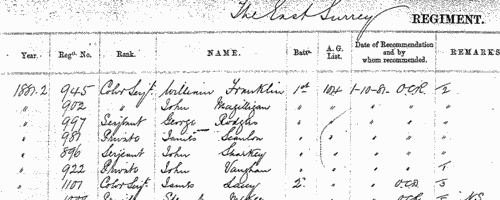
|  Outstanding soldiers of the Leicestershire Regiment
(1881-1901) Outstanding soldiers of the Leicestershire Regiment
(1881-1901)
Each year the best soldiers of the regiment were chosen for long service and good conduct medals. This register gives rank, name, regimental number, and date of recommendation. (The sample scan is from the East Surrey regiment). The register is essentially a register of recommendations, annotated with details of the issue of the medals. Where no gratuity accompanied the medal, the entry is marked 'W. G.' (without gratuity); where, for one reason or another, the medal was not issued, the entry is marked 'N. S.' (not sanctioned) and struck through. The regiment was based on the 17th Regimental District - Leicester. The 1st battalion returned from Bengal in 1882, and in 1885 was at Aldershot. It embarked for Bermuda 16 September 1888, was sent on to Halifax, Nova Scotia, and in 1893 to the West Indies. In 1895 the battalion was moved to South Africa, taking part in the Boer war of 1899 to 1902, fighting at Talana, Lombard's Kop, the defence of Ladysmith, Amesfoort, Ermelo, Geluk Farm, Bergendal and Badfontein; mentioned in despatches at Lyndenburg, operations in the Eastern Transvaal, Swaziland border, South Eastern Transvaal, and Slangapies ("South Africa, 1900-1902", "Defence of Ladysmith"). The 2nd battalion embarked for India 5 October 1876, and in 1885 was at Jubbulpore; it returned from India via Burmah (1888-1889) and Aden 1 December 1890, and in 1895 was at Aldershot. The battalion was moved to Ireland in 1896, and from there to Egypt in 1900. | Sample scan, click to enlarge
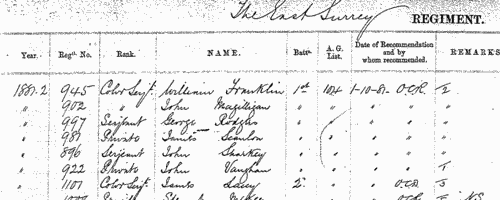
|  Outstanding soldiers of the Prince of Wales' (North Staffordshire Regiment)
(1881-1901) Outstanding soldiers of the Prince of Wales' (North Staffordshire Regiment)
(1881-1901)
Each year the best soldiers of the regiment were chosen for long service and good conduct medals. This register gives rank, name, regimental number, and date of recommendation. (The sample scan is from the East Surrey regiment). The register is essentially a register of recommendations, annotated with details of the issue of the medals. Where no gratuity accompanied the medal, the entry is marked 'W. G.' (without gratuity); where, for one reason or another, the medal was not issued, the entry is marked 'N. S.' (not sanctioned) and struck through. The regiment was based on the 64th Regimental District - Lichfield. The 1st battalion was transferred from the Channel Islands to Ireland in 1879; and from Ireland to England in 1883. In 1884 it embarked for the West Indies; in 1886 was sent from there to South Africa; in 1891 from South Africa to Mauritius; and in 1892 from Mauritius to Malta. In 1895 the battalion was moved to Egypt, taking part in the Dongola Expeditionary Force of 1896; and in 1897 to India. The 2nd battalion was serving in India in 1881, based at Quetta by 1885, and returned to England via Aden 30 March 1888. Having been moved to Ireland in 1893, it was sent to South Africa in 1900, and added "South Africa, 1900-1902" to the regimental honours. | Sample scan, click to enlarge
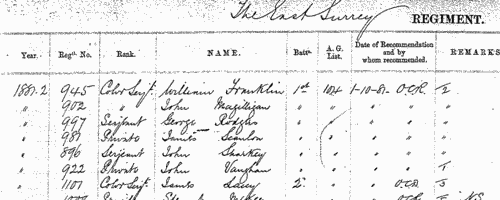
|  Outstanding soldiers of the Royal Scots (Lothian Regiment)
(1881-1901) Outstanding soldiers of the Royal Scots (Lothian Regiment)
(1881-1901)
Each year the best soldiers of the regiment were chosen for long service and good conduct medals. This register gives rank, name, regimental number, and date of recommendation. (The sample scan is from the East Surrey regiment). The register is essentially a register of recommendations, annotated with details of the issue of the medals. Where no gratuity accompanied the medal, the entry is marked 'W. G.' (without gratuity); where, for one reason or another, the medal was not issued, the entry is marked 'N. S.' (not sanctioned) and struck through. The regiment was based on the 1st Regimental District - Glencorse. The 1st battalion embarked for Malta 26 January 1878, half the battalion being sent instead to the West Indies, where the halves rejoined in 1882. In 1884 the battalion was sent to the Cape of Good Hope; it returned from South Africa 30 August 1891, and in 1895 was at Chatham. In 1896 it was moved to Scotland, and in 1899 embarked for South Africa, adding "South Africa, 1899-1902" to the regimental honours. The 2nd battalion returned from Bombay in 1880, was moved from England to Scotland in 1884, and in 1885 was stationed at Edinburgh; having returned to England in 1897, it embarked for Malta 11 December 1890, and went on in 1892 to India. By 1895 the 2nd battalion was at Belgaum in Madras | Sample scan, click to enlarge
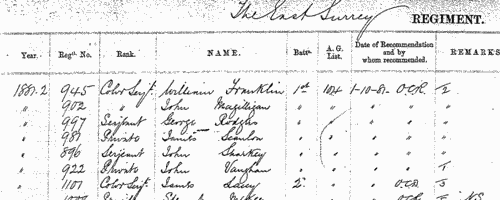
| Unclaimed Naval Prize Money
(1855-1902)
Various prize moneys were awarded to officers and men who served on board her Majesty's ships. For one reason or another a substantial number of these prizes, from as little as a shilling or two to as much as many pounds, remained undistributed by 1902, when this comprehensive list of the unclaimed moneys was printed: it lists unclaimed shares of prize money, slave and pirate bounties, salvage awards, parliamentary grants, gratuities and other moneys distributed by the Admiralty 1855 to 1902, but which omits moneys for service on the China Station during the war of 1856 to 1880, and special gratuities for service in Egypt (1882), Soudan (1884) and Soudan and Nile Expedition (1884-1885), for which there are separate indexes. In each case the sailor's name is given first (surname, then christian name or initials); rank or rating; ship in which serving at time of capture or award; and the amount due. | Sample scan, click to enlarge

|  London Metropolitan Police
(1892-1902) London Metropolitan Police
(1892-1902)
The London Metropolitan Police Register of Joiners (MEPO 4/336) lists policemen joining the force 1 January 1892 to 23 June 1902 (warrant numbers 77319 to 88811). The register is alphabetical, in so far as the recruits are listed chronologically grouped under first letter of surname. It gives Date of Appointment, Name, Number of Warrant, Cause of Removal from Force (resigned, dismissed, promoted or died), and Date of Removal. A final column of 'Remarks' is largely blank, but occasionally gives an alias or a cross-reference to another warrant number. | Sample scan, click to enlarge

|  British artillerymen fighting in South Africa
(1899-1902) British artillerymen fighting in South Africa
(1899-1902)
The Queen Victoria's South Africa Medal was awarded (after her death, in the event) to all who had served honourably in the various campaigns in the Boer War. Returns were made from each unit, and consolidated into nominal roll, of which this is the one for the Royal Artillery. Confusingly, the ledgers used had originally been printed for a register of men transferred (or re-transferred after mobilization) to 1st Class Army Reserve. All the original column headings were therefore struck through, and the roll was prepared with this information: Date of Issue; Regimental Number; Rank; Name; Unit; Medal (a 1 indicating that a medal was awarded); [number of] Clasps; the reference to the source in the original returns, usually starting with AG for papers in the hands of the Adjutant-General, and 68/Art/ for the Royal Artillery records. The final column, normally left blank, was occasionally used for explanatory remarks. | Sample scan, click to enlarge

| Boys entering Haileybury College, Hertfordshire
(1902)
Haileybury College, near Hertford, was founded by the East India Company in 1806, and incorporated by Royal Charter in 1864. This register of pupils entering the school from 1862 to 1931 was edited by a master there, Laurence Arthur Speakman. The boys are listed by term of joining the school, and then alphabetically by name (in bold), surname first (in capitals). There is then usually a precise birthdate, and the name and address of his father; his period at the school, starting with abbreviations to indicate the house to which he belonged (B., Batten; B. F., Bartle Frere; C., Colvin; E., Edmonstone; Ha., Hailey; Hi., Highfield; L., Lawrence; Le B., Le Bas; M., Melvill; Th., Thomason; T., Trevelyan), and the first and last forms attended (e. g., IV., fourth form). Where a member of a school team there is then an indication (e. g., XI., cricket). For some pupils, with whom the school had lost touch, Speakman was only able to record the details of their time at Haileybury; but for most a brief career synopsis is then given, and current address (as in 1931) or date of death.
| Sample scan, click to enlarge
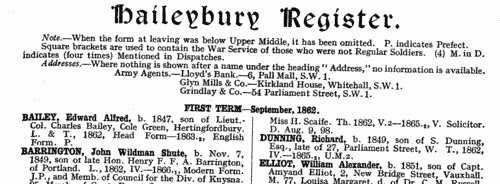
| Boys entering Clifton College
(1903)
Clifton College near Bristol was established in 1862. This edition of the Clifton College Annals and Register for the Old Cliftonian Society by F. Borwick was published in 1925. Boys are listed alphabetically by term of entry, with full names, surname first, in bold. Father's (or widowed mother's) name is given (surname and initials) in capitals, and address. Then there is the name of the house (N. T., North Town; S. H., School House; S. T., South Town), first and last forms, distinctions in school work and games, and month of leaving. Where known, the editor then gave a career summary with month of death; or, if still living, address as in 1925 (in italics). | Sample scan, click to enlarge
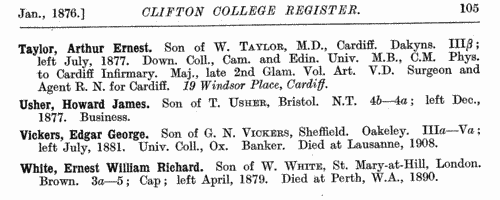
| Boys entering King William's College, Isle of Man
(1903)
King William's College at Castletown on the Isle of Man was established in 1830. By 1928 about 290 boys were being educated there, 'of whom three-fourths are boarders, and the remainders sons of natives or residents in the Island.' Boys entered the junior school about 9 or 10 years of age, the upper school about 13; boys over 13 were not admitted 'unless attainments and character are specially satisfactory'. There were 'several nominations for the sons of clergy and others'.
Editions of the college register were published in 1905 and 1927. When this third edition was prepared, in 1956, it was felt unnecessary to repeat the whole of the register from 1830 onwards, a new starting point being chosen as September 1886, when the reverend Frank Bridgman Walters took office as principal.
The items are arranged alphabetically within term of entry; surname is given first, in bold, and then full christian names; then, to the right, in bold, precise date of birth, school house, and month of leaving the school. The abbreviations for houses are: C, Colbourne; D, Dickson; H, Hunt; Ha, Hangoside; J, Junior House; R, Raglan; S, School House (formerly Principal's); T, town houses occupied by masters who took in boys prior to September 1889; Tr, Trafford's; W, Walters.
Each entry then gives the boy's father's name (surname and initials) and address at that time; school honours (such as Prae., praepositor, XI, school cricket team); a career synopsis; and finally, in italics, to the right, year of death, or present address in 1956, if known. | Sample scan, click to enlarge
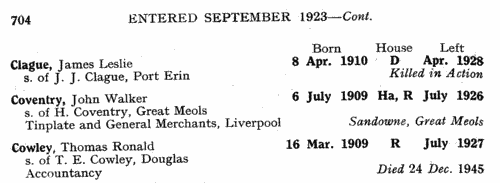
|
Research your ancestry, family history, genealogy and one-name study by direct access to original records and archives indexed by surname.
|












